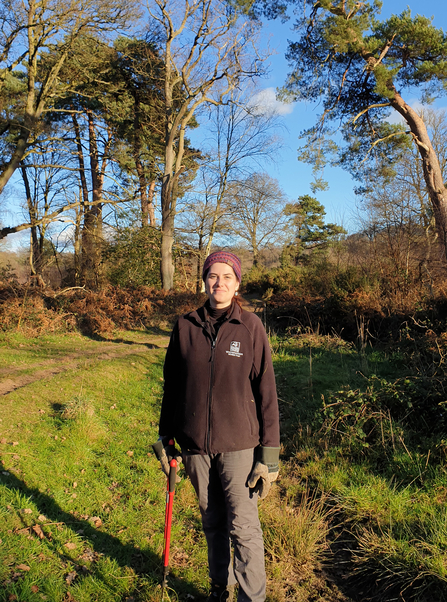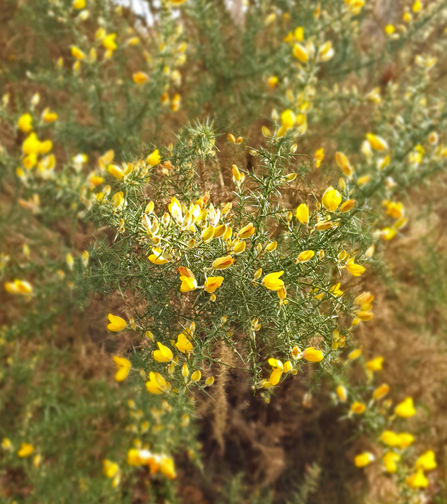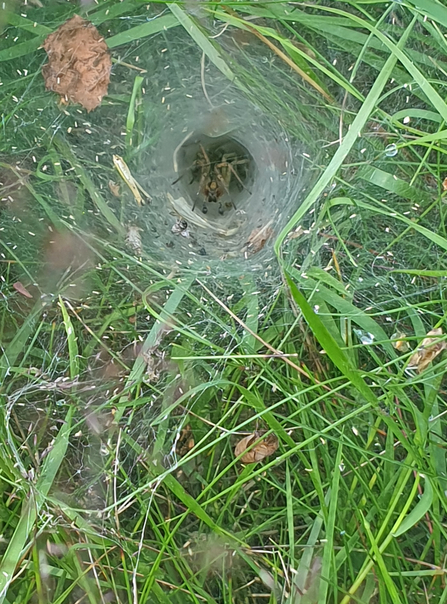During my traineeship I’ve been able to learn lots of different management techniques for the different habitats that I’ve visited. I’ve been to woodlands, meadows and marshes to name a few and learnt how best these places are managed for wildlife. One of my favourite habitat types has got to be heathlands. Before starting my traineeship I regularly attended work parties at The Devil’s Spittleful and during my degree I spent time on the heaths at Cannock Chase, completing different types of wildlife surveys, and so I guess these experiences are where my love for heaths originated.
A love of heathlands
The Devil's Spittleful by Lydia Rackham

Lydia at The Devil's Spittleful
I recently joined the roving volunteers for a scrub clearance task at The Devil’s Spittleful and realised just how much my knowledge has grown when it comes to how best manage these beautiful places. In England we have lost an estimated 85% of heathland habitats so to be able to take part in the conservation of some of the remaining heathlands in Worcestershire is really important.
Providing they are managed properly, the diversity of wildlife on a heathland site can be high and the valuable mosaic of habitats they provide are crucial for a variety of wildlife such as birds, reptiles and invertebrates. I thought I’d take a closer look at some of the habitats you can find on a heathland, why they are important and how they are effectively managed – hopefully you’ll be able to see how important these scrub clearance tasks help to keep our heathlands great for wildlife!
Scrub and trees
These need to be managed so that the heath doesn’t become a woodland. Species such as birch, which is a pioneer species, can colonise an area quickly and this is where management is needed. Cutting down and removing the birch is important to allow the heath to remain as an open habitat where the heather can continue to grow and not become shaded out. Regular volunteer work parties help to cover large areas and really make a difference in keeping the open nature of a heathland landscape. An added bonus of the work completed on The Devil’s Spittleful is that the local giraffes as neighbouring West Midlands Safari Park happily take the brash off our hands - it's a much appreciated treat for them whilst helping us to remove the birch off site.
Other species, such as broom, also need to be controlled by removing them. We usually use a device known as a tree popper, which is a handy tool for this type of task. It took me a while to master how to use them but once you get the hang of it, they’re great for removing broom and smaller birch trees.

Gorse by Lydia Rackham
As many ground-nesting bird species can be found on heathland sites, including wood warblers and tree pipits, keeping some scrub areas for nesting birds is important; species such as bracken, common gorse and bramble are welcome as long as they are maintained and controlled. One of my favourite things to see is the bright yellow flower of gorse (they flower through most of the year) as it adds a much needed splash of colour on some of the more dreary days!
Bare ground
Keeping a good amount of bare ground is also important as it provides different functions for different species. For reptiles such as the common lizard, for example, it provides an ideal area for basking and hunting whereas it can provide great nesting areas for insects like bees and wasps.
In addition to the removing vegetation with tools, grazing is also a great way to keep an open heathland and keep areas of bare ground. In conjunction with Wyre Forest District Council's Rangers, cattle graze The Devil's Spittleful to keep the scrubby areas in check.

Labyrinth spider by Lydia Rackham
Heath and grasses
Heather is the species we most often think of when we think of heathlands; bell heather can be found on The Devil’s Spittleful and from July to September the nature reserve looks fantastic, full of the purple-pink flowers. Not only does heather provide a great habitat for wildlife but it is an important nectar source for many insects too. Grasses also provide great habitats for invertebrates; a great example is of the labyrinth spider I spotted in the summer!
Woodland and Woodland edges
Whilst the heathlands are best kept as open spaces to allow heather to flourish, wooded areas are important for many species as it provides shelter, nesting opportunities, future deadwood habitat and spots to hibernate in. Small woodland patches are kept to help increase diversity.
I’m lucky that I get to visit The Devil’s Spittleful regularly, continuing to join in the work parties each month. I love to see the different species it offers over the year, from the abundance of fungi later in the year to the multitude of bird species seen from spring onwards (it was the place I heard my first cuckoo, which was amazing). The traineeship has improved my knowledge on heathlands and their management and only developed my love for them even more.
If you'd like to help us to manage The Devil's Spittleful, why not come along to one of our conservation work parties? We're also looking for enthusiastic people to join us as engagement volunteers to help visitors understand more about the wildlife of this beautiful spot. And if you'd like to know more about how we're planning to create Worcestershire's largest block of heathland, have a read of our Heathland Heroes page.

